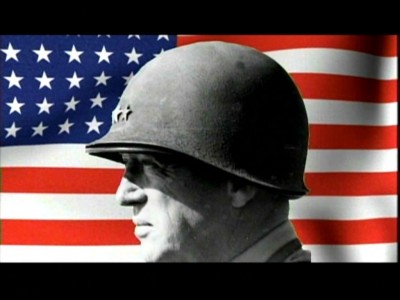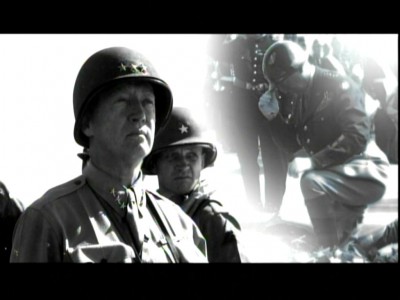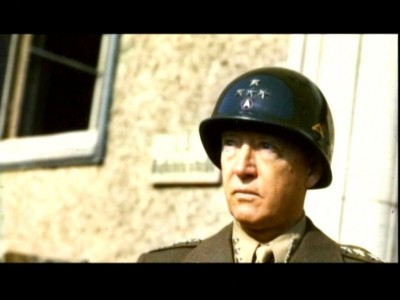| Reviews & Columns |
|
Reviews DVD TV on DVD Blu-ray 4K UHD International DVDs In Theaters Reviews by Studio Video Games Features Collector Series DVDs Easter Egg Database Interviews DVD Talk Radio Feature Articles Columns Anime Talk DVD Savant Horror DVDs The M.O.D. Squad Art House HD Talk Silent DVD
|
DVD Talk Forum |
|
|
| Resources |
|
DVD Price Search Customer Service #'s RCE Info Links |
|
Columns
|
|
|
Patton 360: The Complete Season 1
History has released the strangely-titled Patton 360°: The Complete Season One, a three-disc, 10-episode set of the 2009 CGI-crammed military documentary following the celebrated 4-star General's career during the Second World War. I write "strangely titled" because that "Complete Season One" seems to indicate they'll be a second season...which would be a neat trick since these 10 episodes cover all of Patton's major campaigns as well as his rather bizarrely mundane death (from a car accident). Odd moniker aside, Patton 360°: The Complete Season One seems to rely a tad less on the CGI than say, Dogfights or Battleship 360°, but it should satisfy that growing group of viewers who get a gaming fix out of these CGI battle docs.

Covering all of the major battles Patton participated in during WWII, Patton 360° immediately jumps into the fray by detailing the Allies' first incursion into North Africa - Operation Torch - where Major General George S. Patton led the Western Task Force in an assault on Morocco, then held by the French collaborationist Vichy government. After the sorry spectacle of former ally France firing on landing American troops (and the bravery of isolated French Resistance forces trying to aid the invasion - a fact the documentary doesn't highlight), Casablanca quickly fell under the punishing assault by the Allies. Patton then received word in 1943 that he would be replacing Major General Lloyd Fredendall as commander of the U.S. II Corps, after their disastrous defeats at the Battle of Sidi Bou Zid and more famously, at the Battle of Kasserine Pass. General Dwight D. Eisenhower, once a former protégé of Patton's but now his superior, promoted Patton to Lieutenant General and entrusted him with the task of whipping the inexperienced, demoralized American troops into a competent fighting unit. In this task, Patton became famous for his zealous discipline (for example: all officers were to wear ties, even in battle), as well as for uncompromising demands for excellence from his troops (these months in North Africa are probably best known to moviegoers as the opening sequences of the 1970 biopic, Patton, with George C. Scott). U.S. II Corps counter-attacked against General Erwin Rommel's Afrika Korps, and along with General Sir Bernard Law Montgomery's British Eighth Army, created a pincer effect that eventually defeated the Germans and Italians in North Africa.
Due to his success in North Africa, Patton was again chosen by Eisenhower to support Montgomery's Eighth Army in the assault on Sicily - the Allies' first step towards the invasion of the European continent. Leading the Seventh Army, Patton hammered through the island to Palermo, and then met Montgomery in Messina. At this point, it was assumed - particularly by the German High Command who rated Patton as their deadliest Allied commander - that Patton would have a leading role in the upcoming Allied invasion of France. But a disgraceful incident involving the slapping of two soldiers almost ended Patton's career, with Eisenhower taking this opportunity to sideline his best general...and use that action as a diversion for the curious German intelligence operatives. Since the German High Command couldn't conceive of anyone but Patton leading the French invasion forces, Ike's decision to keep Patton in Sicily for 10 months convinced the Germans that the invasion would come in the south of France, thereby helping to divert German forces from Normandy that would have greatly impacted the D-Day landings.
Patton would eventually come out from under the cloud caused by the slapping incidents when Eisenhower tapped him for Operation Cobra, the U.S. Third Army's mission to break up the fighting that was still bogged down in the Normandy hedgerows almost two months after D-Day. With lightening speed, Patton and his army captured several hundred thousand German troops in operations between Brittany and the Seine, and then pushed on into Northern France, eventually halting at the Moselle River only for lack of gas for his armor (resources were diverted not only for Montgomery's ill-fated Operation Market Garden - the subject of A Bridge Too Far - but also because Eisenhower preferred a "broad front" approach to assaults that didn't outstrip supply line capabilities, as happened to Patton's spearhead). This slow-down resulted in the Germans being able to regroup for major counter-offenses at the Battle of Arracourt and during the bloody siege of Metz - both unsuccessful for the Germans but highly costly for the Allies in terms of casualties.
In what some would say was Patton's most remarkable achievement in battlefield logistics, the winter 1944 Ardennes offensive by the seemingly defeated German troops, "The Battle of the Bulge," came during one of the worst winters on the European continent in decades. The Germans assembled over a quarter of a million men and flooded a thin stretch of the Allied lines in Belgium and headed for the Meuse River. The Allies, caught be surprise, were fortunate in the fact that Patton saw the enormity of what was happening early on, and moved a sizeable number of his men north towards the attacking Germans, eventually helping to relieve the siege town of Bastogne. Patton continued on into Germany after the "Bulge's" failure, eventually moving over into Bohemia and Czechoslovakia, liberating the Pilsen concentration camp. Patton didn't receive a Pacific command when the hostilities in Europe were over, instead being assigned the light duty of the military commander of Bavaria (Patton had continued to isolate himself from his superior, Eisenhower, with politically-charged comments about our then-ally, Russia, after combat operations in Europe ended). Patton, in a bizarre, ironic twist for a military leader who believed in commanding right at the dangerous front line, was paralyzed in simple automobile accident in 1945, dying several days later from a pulmonary embolism on December 21, 1945. He was only 60 years old.
I have to be honest in writing that I was a little disappointed with Patton360° in comparison with Battleship 360°, even though I actually caught Patton first on cable and enjoyed it during the couple of episodes I caught. As I stated in my Battleship 360° review, there was an emotional connection that built throughout the running of that documentary series that was further heightened by the series' focus on that one ship - the U.S.S. Enterprise. As the episodes unfolded, the viewer became more and more familiar with the various crewmen who lived and fought on the Enterprise, while the ship itself became the central character in the series. You pulled for the ship to make it through one incredibly dangerous engagement after another. This narrow focus on one ship provided an opportunity of great depth in exploring the tactics and strategies that were employed by U.S. naval forces during this period of WWII, as well, along with the technological innovations aboard the Enterprise - innovations that helped it survive so many attacks by the enemy.
I didn't feel any of that with Patton360°. That's not to say the series isn't entertaining or without worth. It is. Remaining focused on Patton's military engagements (while leaving biography and politics largely behind), the series can't help but be exciting and fast-paced; the series' structure conforms perfectly with Patton's preferred method of lightening-fast, pounding frontal assaults. Patton360° is never boring. But as for any emotional involvement outside of the individual soldiers' stories that are recounted.... Perhaps that sense of reserve and distance comes from the series' stand-offish approach to Patton the man. While it might seem admirable for the first episode to jettison background and context in an effort to immerse the viewer immediately into the North African campaign, literally only a handful of lines about Patton's biography up to this point in his life doesn't do justice at all to the man, nor properly align the viewer for what is coming in the next 10 episodes. Who is George S. Patton? How did he get to where he was in 1942, prior to his fateful command of Operation Torch? What forces, what influences, what teachings, what histories shaped and molded Patton to perform the way he did during WWII? We simply aren't told in Patton360°. We're shown plenty of CGI battles, with stats on tanks and other armored vehicles. We hear from more than a few historians, giving insight into the battles in terms their larger place within the war. And we hear quite a few stories - many of them moving or humorous - from veterans who actually served under Patton (they're the best element of Patton360°: thank god their oral histories are being preserved on these documentaries). But we never get a good, clear picture of what Patton360° thinks of its own subject: George S. Patton. In an effort to stay tightly focused on the visually exciting aspects of Patton's military career, the old saw about not seeing the forest for the trees comes true. And if there was any general in WWII whose tactics were informed by their past, by their personality, by their sense of history, it was Patton. Not knowing that context leaves a big hole in Patton360°.
As for those visual aspects of his career - the CGI depictions of his various battle campaigns - I didn't feel they were quite as successful as Battleship 360°'s were, either. Perhaps it's just the nature of the weapons and vehicles involved here. Admittedly, it's much easier to create excitement in a computer-animated sequence that features an airplane zooming in an out of the clouds at hundreds of miles per hour, spitting out lead as it guns down another plane, or as it dive-bombs a ship whose guns are blazing, as well - as opposed to the relatively slow-paced, lumbering tanks that don't do much of anything except crawl over the ground and either blow up stuff or get blown up. Obviously, that's an oversimplification, but when a series such as Patton360° tries to tell history largely through visual means, then it's a valid jumping-off point for criticism: these animated battle scenes just aren't as visually complex and dynamic as the ones in Battleship 360° or Dogfights. And maybe that's why Patton360° seems to have fewer such animated sequences compared to the series previously mentioned. Interviews and newsreel footage dominate, while even a few mocked-up recreations with live actors crept in, a move which seems counter to the essence of these new CGI-animated docs, as well as a step backward in convention for a supposedly innovative History documentary.

Here are the 10 episodes of the 3-disc set, Patton 360°: The Complete Season One, as described on the slimcases:
DISC ONE
Blood & Guts
Patton and the U.S. Army invade North Africa and encounter surprisingly strong pro-Nazi French forces. When a ceasefire is declared, Patton enters the city of Casablanca in triumph.
Rommel's Last Stand
American forces are humiliated at Kasserine Pass, but Patton heads to the front, whips the poorly trained troops into shape, and leads them to victory at El Guettar and eventually, with the help of the British, all of North Africa.
Baptism of Blood
Although Patton and the Allies come up against a surprise counterattack by Italian tanks, they successfully hold the beaches and prepare to push into Sicily to capture the island's capital, Palermo.
Rogue General
Facing a well-entrenched German Army, Patton races against the British Allies to claim the vital city of Messina. But instead of a hero's welcome, the general is relieved of his command for slapping two soldiers.
DISC TWO
American Blitzkrieg
As a ruse to fool the Germans about D-Day, Patton commands a fictitious army in England. Only after the invasion succeeds is he finally able to lead the lightning-fast armored assaults for which he is famous.
Leading the Charge
Patton's Third Army tears through France, moving faster and seizing more territory than any army in history. Within a month they advance to within 60 miles of the German border.
On Hitler's Doorstep
Patton's blitzkrieg is so successful that his army outruns its own supply lines, causing delays that allow the Germans to launch a major counterattack. But even with inferior tanks, the Americans emerge triumphant.
DISC THREE
Siege Warfare
It takes Patton nearly two months to subdue the heavily fortified city of Metz, which is surrounded by nearly impenetrable concrete fortresses, but finally the Americans prove victorious.
Battle of the Bulge
Patton's Third Army races to the rescue of American units under intense attack in Belgium. Despite the worst weather in 20 years, they smash through German lines and relieve the beleaguered forces.
Crushing the Third Reich
Patton beats the British to the Rhine River, launches a rescue mission to save his son-in-law and liberates the Ohrdruf death camp. The war ends with an Allied victory, but before the year is over, the fabled general dies of injuries from a car accident.

The DVD:
The Video:
Again? Seriously? Having watched and reviewed numerous History docs over the past few years, I'm again flummoxed as to why they continually release nice-looking but essentially substandard transfers in non-anamorphic, cropped 1:78:1 widescreen. Why, History? The actual source material is sharp as a tack, with excellent color values and better-than-expected CGI animation. So why not showcase that anamorphically? It's not even funny anymore - it just looks sad, History.
The Audio:
As well, the relatively paltry Dolby Digital English 2.0 audio tracks, while healthy enough with numerous examples of separation effects, certainly don't take advantage of the possibilities inherent in bringing to life these action-filled battle sequences. Close-captions are supposedly available, but they didn't work on any player or monitor I tried (something I've seen with other History releases, as well).
The Extras:
Unusual for a History doc of this nature: no extra features for Patton360°. Nobody could find one old doc on Patton that was used for one of The History Channel countless military programs? Disappointing.
Final Thoughts:
As visual history, it's fast-moving and entertaining. But as biography.... If you already know Patton's life inside and out, I suppose you won't mind Patton360°'s insistence on staying primarily focused on depicting the visual aspects of his battle campaigns. And even though these CGI animated sequences don't quite match up to previous efforts by History, they're still quite engaging. But context is lacking here for an exploration of Patton the man, and increasingly as the battles continue but the man is left behind, one sees Patton360° as just an excuse to crowd some well-wrought animation effects into as short a time as possible in these 10 docs. I'm still going to recommend Patton360° - but only for those interested in these specific kinds of war docs, but it could have been so much more than what it is.
Paul Mavis is an internationally published film and television historian, a member of the Online Film Critics Society, and the author of The Espionage Filmography.


|
| Popular Reviews |
| Sponsored Links |
|
|
| Sponsored Links |
|
|
| Release List | Reviews | Shop | Newsletter | Forum | DVD Giveaways | Blu-Ray | Advertise |
|
Copyright 2024 DVDTalk.com All Rights Reserved. Legal Info, Privacy Policy, Terms of Use,
Manage Preferences,
Your Privacy Choices | |||||||













